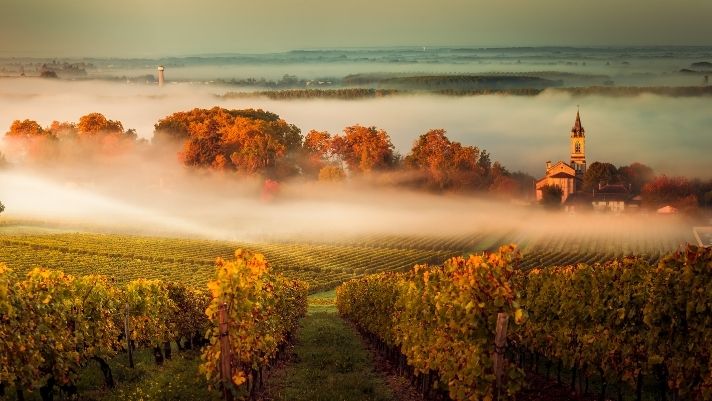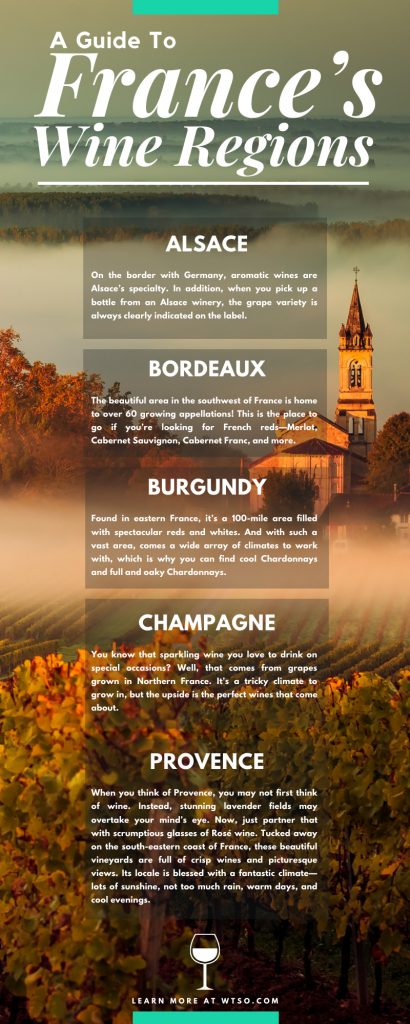Want to learn more about one the most prolific wine makers in the world? Explore this guide to France’s wine regions and begin your wine lesson.
French wine—the authoritative figure that so many other wine-producing regions look toward. There’s an expansive history that comes along with French wines such as specific region preferences, specific laws about specific varieties, and so on. Simply put—French wine comes with rich history.
Now, in order to appreciate French wine, you don’t have to understand how monarchs drank their wine and how vintners readied their valleys. But, what will impact your experience with specific French varieties is understanding how different regions create different wines and how they provide a different wine experience or emphasize specific flavors. It’s all about becoming more familiar with the world of wine.
So, to help you delve into the beauty of French wine, peruse our guide to France’s wine regions. Don’t miss out on this wine lesson of some of the most renowned wine-making regions in the world.
Important Keywords
Terroir
Terroir is the note that different microclimates, soil conditions, and vineyard elevations create unique wines. In short, it is the natural environment in which a wine is produced.
Indication Géographique Protégée (IGP)
“Wine of the Land.” This category includes all wines made from varieties and procedures apart from those mandated by the Appellation d’Origine Controlée (AOC) rules.
Vin de France
“Table Wine” is the lowest level of French wine classification—there are no limits on grape varietals in a bottle, no vintage dates necessary, and no specific vineyard yields.
6 of The Most Popular French Wine Regions
Alsace
On the border with Germany, aromatic wines are Alsace’s specialty. In addition, when you pick up a bottle from an Alsace winery, the grape variety is always clearly indicated on the label.
But that’s not all that’s unique. Vineyards in Alsace are characterized by unique microclimates, steep valleys, unique sun exposures, and more. You can see this in their “Dry Riesling”—traditionally sweet, Riesling produced in Alsace is dry and incredibly aromatic.
It’s also broken into 3 major AOCs: Alsace AOC (white, still wines), Crémant d’Alsace AOC (sparkling white and rosé wines), and Alsace Grand Cru AOC (limited special vineyard wines). This is an important aspect to keep in mind as you further explore this region’s wine.
Typical Grapes:
- Riesling
- Gewürztraminer
- Pinot Gris
Wine To Try:
- Grand Cru Alsace Riesling 2012 Gustave Lorentz Altenberg de Bergheim
- Grand Cru Alsace Pinot Gris 2013 Charles Sparr Brand
Bordeaux
Ah, the French wine region that you’ve been waiting for—Bordeaux. The beautiful area in the southwest of France is home to over 60 growing appellations! This is the place to go if you’re looking for French reds—Merlot, Cabernet Sauvignon, Cabernet Franc, and more.
Now, when it comes to dividing the large region, it’s broken up by a natural divider—the Gironde Estuary. Splitting the region into two subregions, everything left of the estuary is called the “left bank,” and everything on the east is called the “right bank.”
The Left Bank favors Cabernet Sauvignon grapes because the gravel content provides better conditions. On the other hand, the Right Bank’s clay-rich soil is perfection for Merlot Grapes. Basically, each side has its own appellation laws and classification systems because the settings are that varied.
Typical Grapes:
- Cabernet Sauvignon
- Merlot
- Petit Verdot
Wine To Try:
- Château Bois Malot Bordeaux Blanc 2019
- Château La Tour Blanche 1er Cru Classé Sauternes 2009
Burgundy
The other “B” region, Burgundy is another popular area in the French wine-making world. Found in eastern France, it’s a 100-mile area filled with spectacular reds and whites. The vast area comes a wide array of climates to work with, producing an intricate variety of wines.
You can understand the split of climates a bit better with their five primary growing areas: Chablis, Côte de Nuits, Côte de Beaune, Côte Chalonnaise, and Mâconnais. Each has a specific terroir that impacts the wines’ taste.
Typical Grapes:
- Pinot Noir
- Chardonnay
- Aligoté
Wines To Try:
- Red Burgundy 1er Cru Pommard Epenots Domaine Moillard 2005 – a specific Pinot Noir
- Lamblin et Fils Chablis White Burgundy 2019 – a specific Chardonnay
Champagne
You know that sparkling wine you love to drink on special occasions? Well, that comes from grapes grown in Northern France. It’s a tricky climate to grow in, but the upside is the perfect wines that come about.
The region is divided into three areas—Montagne de Reims, Côte des Blancs, and Vallée de la Marne. Vast majority of the wineries in these areas use a labor-intensive, traditional method to create the bubble. Called Méthod Champenoise, the wine is fermented twice in the bottle.
Typical Grapes:
- Chardonnay
- Pinot Noir
- Pinot Meunier
Wine To Try:
- Champagne De Saint Gall Grand Cru Blanc de Blancs Brut 2012
- Champagne Premier Cru Blanc de Noirs Brut NV André Chemin Tradition
Pro-Tip: Unless a winery uses the méthod Champenoise within the Champagne region, then it cannot call a wine “Champagne.” It is simply a sparkling wine.
Loire Valley
Found in the northwest part of France, Loire Valley is home to some beautiful white wines, but maybe not the ones you’re used to. In actuality, the Loire Valley is actually one of the most diverse regions in terms of grape varieties.
Here you’ll find the crisp, floral whites of Sancerre and Muscadet to the fuller-bodied realm of Chenin Blancs. The variety of this region comes down to the cool-climate—meaning that reds are lighter, whites are crisper, and all of it is delicious. When you visit this region, you’ll get food-friendly wines, modest price tags, and new sips every day.
Typical Grapes:
- Chenin Blanc
- Cabernet Franc
- Sauvignon Blanc
Wine To Try:
- Le Fresnay Muscadet Sevre Et Maine Sur Lie 2015
- Cherrier Père et Fils Sancerre Les 7 Hommes 2019
Provence
When you think of Provence, you may not first think of wine. Instead, stunning lavender fields may overtake your mind’s eye. Now, just partner that with scrumptious glasses of Rosé wine.
Tucked away on the south-eastern coast of France, these beautiful vineyards are full of crisp wines and picturesque views. Its locale is blessed with a fantastic climate—lots of sunshine, not too much rain, warm days, and cool evenings. It was once an underrated wine region, but it’s definitely climbing the ranks as a region making an impact.
Typical Grapes:
- Ugni Blanc (Trebbiano)
- Grenache Blanc and Grenache Noir
- Cinsault
Wine To Try:
- Château Paradis Grande Terre Rosé Coteaux d’Aix en Provence 2019
- Mourvèdre, which is popular in Châteauneuf-du-Pape blends
Other French Wine Regions
- Beaujolais
- Corsica
- Languedoc & Roussillon
- Rhone Valley
- Sud-Ouest (South West)
This was your guide to popular French wine regions—keep doing your wine history research to learn more about how your favorite wines change depending on locale. And when you’re done researching and want the real deal, turn to Wines ‘Til Sold Out. We have a great variety of French wines for you to try—from our top-rated red wines to our beautiful sparkling wines. Peruse our site and order a few bottles that strike your fancy!





Great introduction and overview of the French wine.
I am looking forward to the see same summaries for Italie and other countries. Eventually, doing the same exercise but for a region?
Hi Louise, really glad you enjoyed this post! Here’s a similar one on some of Italy’s popular wine regions: https://www.wtso.com/blog/a-guide-to-italys-wine-regions/